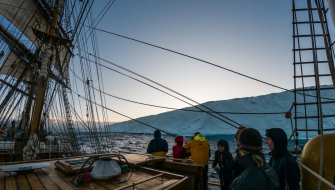On our way South
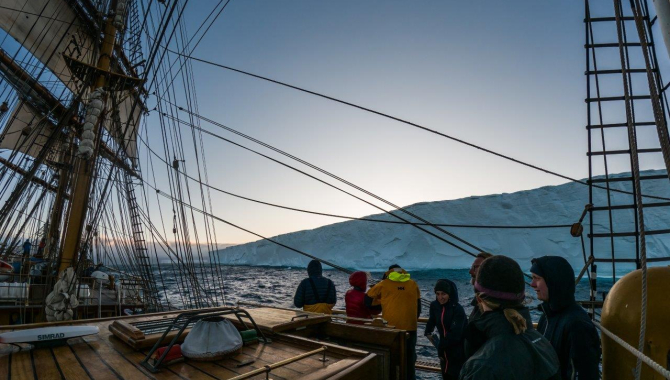
Last day on the island. Blown off Gold Harbour and in the afternoon, zodiac cruise at Cooper Bay.
We got into the small bay of Gold Harbour in the early morning, and there the anchor goes down and holds pretty well in the windy conditions the Europa finds here.
Gold Harbour opens just south-southwest of Cape Charlotte, a scenic spot, steep-sided and with the picturesque Bertrab Glacier at its head.
Its name is of unknown origin—no gold is to be found here, but maybe the warm light of sunsets over the glaciers and cliffs around inspired the early sealers that used the area during the late 1800s and early 1900s.
White caps over the sea, gusts up to 35 knots—it all makes for delaying a bit the morning attempt to land and waiting to see if conditions abate. As soon as we consider that it might be possible to launch a scout zodiac between gusts, guides take a ride to the beach. A wet ride it was: too windy, and the surge at the beach was too large for a safe operation. We will have to move to the next location and try our luck there. Nevertheless, the views from the ship are superb.
The harbour is framed by steep cliffs on a sort of amphitheater, which climbs up to high peaks along one half of its length. Flowing down from them are the narrow tongue of the Bertrab Glacier and several waterfalls. The rest of the bay is tussock grass, covering a set of steep slopes.
The area down below all that is a good breeding ground for Gentoo and King penguins, and along the sandy beach, Elephant seals breed, especially at the west end of the cove, where a glacial meltwater stream flows.
Above our heads, lenticular clouds tell us about the strong winds higher up in the atmosphere as well.
Time for bringing the anchor home and setting course to Cooper Bay. Located at the southwestern tip of South Georgia, it will be our last stop on the island before setting sail towards our next goal, Antarctica.
Cooper Bay, despite not being such a large feature, is home to several small coves and beaches. Along the sandy areas and tussock grass slopes, Chinstrap and Gentoo penguins can be found, together with some of the ubiquitous Kings. But the idea here is to zodiac cruise the area, paying a visit to them but with the goal of reaching the rocky walls and cliffs at the entrance of the bay. There, a Macaroni penguin rookery can be seen from the boats.
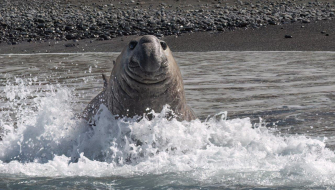
At the start of the afternoon cruise, we steer the zodiacs towards the secluded beaches of the coastline first. Hundreds of Giant petrels (both Northern and Southern) patrol the waters in search of seal carcasses, others just rest ashore, while some seem to be lucky enough to have found food—a dead seal pup to feed on. Along the sandy bits of coastline, Fur seals are starting to crowd the place while numerous Elephants still hang around. Many pups lay and rest, but also adults are here.
Imagine for a second you are an Elephant seal. If it happens that the seaside you chose this season is not crowded, you can succeed as the unchallenged master of the beach. That rarely happens. Virtually every suitable place, every sandy, pebble, or rocky shore of the island, is teeming with wildlife. Most surely another large male will land at the same spot as you. And probably not just one. They all come here for the same reason: the females that start reaching the island a bit later than them. If until now your fighting has been just for a portion of space, now they become bloody and violent. The largest, heaviest, loudest, and strongest will have the chance to win the brawls and mate. You’ll be tired, possibly carrying injuries and scars, and you will lose lots of the precious fat you have been storing for that moment, but you’ll be passing your genes for those desirable characteristics to the next generation.
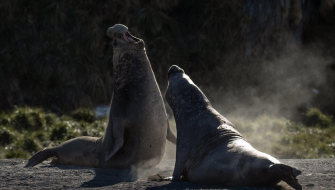
The peak of the Elephant seal season has passed, but still, this game is going on for some of the late harems or a few of the individuals that arrived late to South Georgia and thus delayed this breeding cycle. All of this happened before our eyes as we drove by on our boats.
Then we aim for the rocky areas in search of the elusive Macaroni penguins. And there they are, amongst shallows and rocks awash. They land and climb the steep slopes to their colony higher up the hills. Numerous as they are on the island, they are not the easiest to see; first, you need to reach the exposed and unsheltered areas where they nest. But this place is one of the few accessible ones.
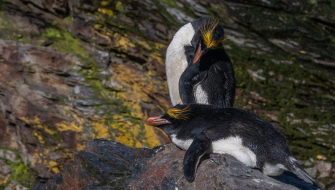
Their curious name comes from the ‘macaroni’ or ‘yankee doodle’ feather that was in the hats of stylish young Italian men during the 1920s. And indeed, stylish penguins they seem, with their bright yellow crests above their eyes and meeting in the forehead.
But still, the afternoon in the boats was not finished yet. Driving a bit further, we have a good look at the so properly called Albatross Cove. Here, perched on the rocks and vertical cliffs where tussock grass hangs, several nests of the beautiful Light-mantled albatrosses can be found. Not easy to spot, but in the end, we all could enjoy the comings and goings of some of them to and from their nests. A lovely sight as a closure to our activities in South Georgia.
Back on board, everything is being readied for departure. Safety lines and nets are being rigged, decks are cleared up and prepared for sailing, and items are being sea-stowed below decks. Lower Topsails are already being unfurled. And not much later, we are on our way.
Blustery conditions are hard around the southern corner of South Georgia. Rugged coastline, high glaciated mountains, and large tabular icebergs stuck around the shallows and rocks out of Cooper Bay and Drygalsky Fjord produce obvious changes and intense local effects over the general forecast. After heaving anchor and starting our way south, the forecast says 15 knots, but 35 knots show up in the ship’s anemometer.
In a quite epic farewell to the island, we start the new leg of our trip, steering the ship in those conditions amongst the huge icebergs that have drifted here from Antarctica and now rest aground here, at the southern tip of South Georgia. For the next few days, there we aim to go: to the continental ice caps, ice shelves, and glaciers from where they have broken up and calved.
